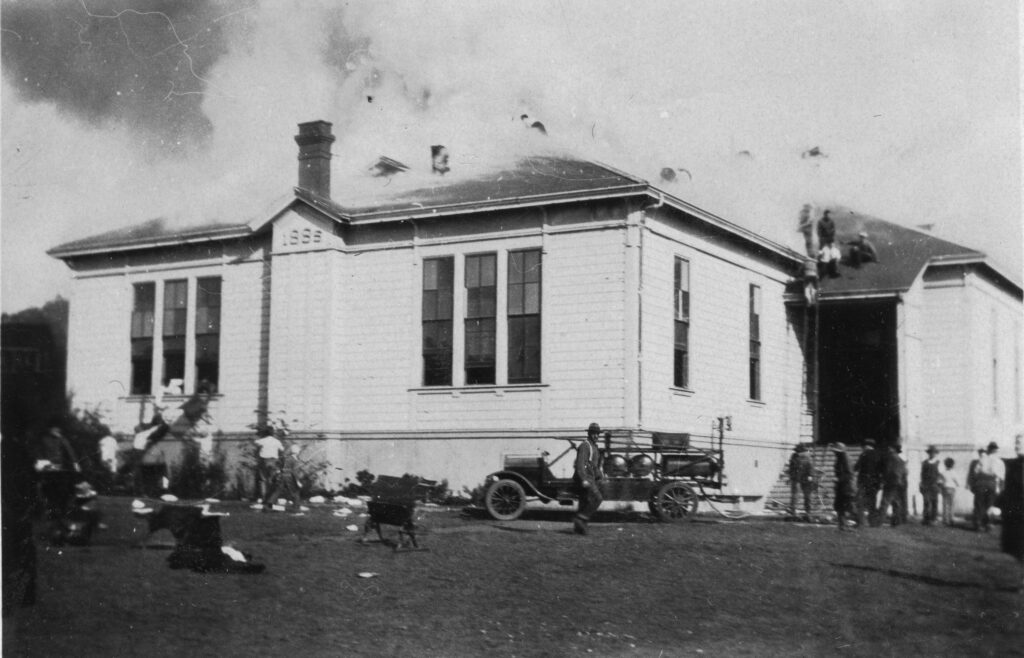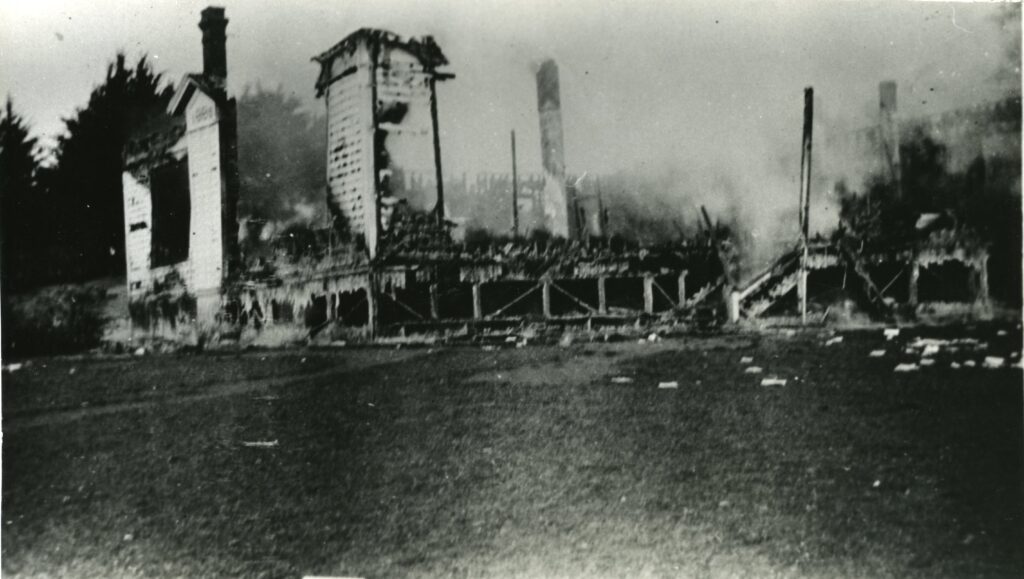“What Became of the Little Red Schoolhouse” is a five-volume compilation of information on more than 200 schools that once existed in Mendocino County. Sponsored by the now long-gone Mendocino Coast Genealogical Society, its researchers tried to assemble the who, what, when, where, why and how of every school’s history. One thing the compilers looked for was anything unique about an individual school. We’ll start with this story from 1929.
On December 3rd, a runaway horse from a nearby ranch appeared on the Mendocino Grammar School grounds and proceeded to enter through the open door to the north, run through a long hallway, and exit through the south door. Exciting stuff for school kids! But teachers quickly called a “fire drill” as smoke appeared and the school was quickly evacuated. The fire department couldn’t control the blaze and in the end all that remained standing was the bell tower and the chimney with its 1885 build date plaque. It was speculated that vibrations from the horse’s hooves dislodged the wood-fired furnace and the bricks around it, spilling hot embers that started the fire.
When Mendocino High students wanted an athletic field, they did it themselves. First, they got landowner Auggie Heeser to donate the land north of the existing campus. Because they wanted a running track, they then went to the county road supervisor and asked him to send a grading machine and operator to scrape out an oval running track. Next, they went to the sawmill down on Big River flat and asked for cinders from the steam boilers to create a proper surface. Before they knew it, they had a track for athletic competition. Good Work!
Up at Caspar in the 1930s, kids were offered a choice for their secondary school. At the time, a bus came south from Fort Bragg High, and a bus came north from Mendocino. High school-aged kids from Caspar had to pick one or the other. By 1940, only those living north of Jug Handle Creek got to go to Fort Bragg High.
The Woods School on the South Fork of the Noyo River 15 miles inland was built on runners or skids. Buildings at logging camps, including the schools, were designed and constructed to be taken apart and moved when necessary onto railroad flat cars and then reassembled at the new location. On Highway 20 near Chamberlain Creek, the rest area has this very school on display nearby.
According to the Beacon, a belfry was added to the roof of Little River School in 1883. The bell came from the shipwrecked “Maria Marino,” a Chilean ship sunk off the coast. Someone managed to save the bell and give it to the school.
Kaisen School was located on the way out to Comptche, just before the road today dips down toward Tunzi Ranch. It existed for 45 years until enrollment got so small just one student was left, Alice Piccolotti (Ivec). Her family lived down below on Big River and she hiked uphill to school or boarded with a local family. In eighth grade she was the sole student, as all other schools were too far away. The Kaisen School closed the next year.
Where today’s Comptche School sits a half mile west of Comptche Corners was the location of the first school in 1872. Two later schools on Flynn Creek Road were used for decades. In the early 1980s, this correspondent was the Comptche representative on the School Board. The existing deteriorated concrete foundation on that school could be scraped out with a bare hand and the building met no earthquake standards. Rebuild or Replace? At the time, the Blue Rose restaurant in a converted barn was for sale and it was on the site of the very first Comptche School. By November 1984 it had been purchased, remodeled, and became a school.
The Hansen School on Orrs Springs Road, east of Low Gap Road, began in 1891. There was a giant forest fire there in 1931. An excerpt from a former student’s memories stated, “I remember standing at the window watching the flag on top of the flagpole catch on fire.” Everyone evacuated the area quickly and survived.
In future Kelley House columns, there will be more peeks into unique historic trivia from other county schools.

